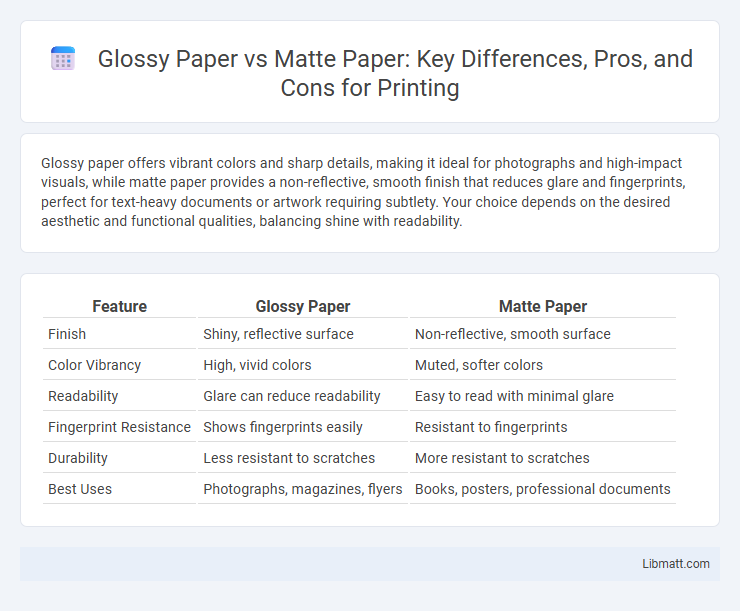Glossy paper offers vibrant colors and sharp details, making it ideal for photographs and high-impact visuals, while matte paper provides a non-reflective, smooth finish that reduces glare and fingerprints, perfect for text-heavy documents or artwork requiring subtlety. Your choice depends on the desired aesthetic and functional qualities, balancing shine with readability.
Table of Comparison
| Feature | Glossy Paper | Matte Paper |
|---|---|---|
| Finish | Shiny, reflective surface | Non-reflective, smooth surface |
| Color Vibrancy | High, vivid colors | Muted, softer colors |
| Readability | Glare can reduce readability | Easy to read with minimal glare |
| Fingerprint Resistance | Shows fingerprints easily | Resistant to fingerprints |
| Durability | Less resistant to scratches | More resistant to scratches |
| Best Uses | Photographs, magazines, flyers | Books, posters, professional documents |
Introduction to Glossy and Matte Paper
Glossy paper offers a shiny, reflective finish that enhances color vibrancy and sharpness, making it ideal for photos and marketing materials. Matte paper provides a non-reflective, smooth surface that reduces glare and fingerprints, perfect for professional documents and readable text. Choosing between glossy and matte paper depends on your desired visual effect and practical needs for presentation or durability.
Key Differences Between Glossy and Matte Paper
Glossy paper features a shiny, reflective surface that enhances color vibrancy and sharpness, making it ideal for photos and marketing materials where visual impact is crucial. Matte paper has a non-reflective, smooth finish that reduces glare and fingerprints, offering a more subtle, professional look suited for text-heavy documents and art prints. The choice between glossy and matte paper affects print durability, color saturation, and suitability for different lighting environments, influencing the final presentation quality.
Print Quality: Glossy vs Matte
Glossy paper enhances print quality by producing vibrant colors and sharp contrast, making images appear more dynamic and eye-catching. Matte paper, however, offers a smooth, non-reflective surface that reduces glare and fingerprints, delivering a softer, more subdued appearance ideal for text-heavy documents or artistic prints. Choosing between glossy and matte depends on the desired visual impact and usability, with glossy excelling in photo clarity and matte excelling in readability and reduced glare.
Image Vibrancy and Color Reproduction
Glossy paper offers superior image vibrancy and color reproduction due to its smooth, reflective coating that enhances sharpness and saturation, making colors appear more vivid and intense. In contrast, matte paper diffuses light, resulting in softer images with less glare and muted colors, which can reduce the impact of bright or highly detailed photos. Choosing between glossy and matte paper depends on whether vividness or subtlety in visual presentation is prioritized for the printed material.
Texture and Surface Feel Comparison
Glossy paper features a smooth, shiny surface that enhances color vibrancy and sharpness, making images appear more vivid and detailed. Matte paper offers a non-reflective, velvety texture that reduces glare and fingerprints, providing a more subdued and professional look. Your choice between glossy and matte paper impacts the tactile experience and visual impression, depending on the desired aesthetic and practical use.
Glare, Reflection, and Viewing Experience
Glossy paper produces higher glare and reflections due to its smooth, shiny surface, which enhances color vibrancy but can cause discomfort under bright lighting. Matte paper reduces glare and reflections with its textured finish, offering a more subdued, glare-free viewing experience ideal for reading and detailed work. Your choice between glossy and matte paper affects how light interacts with the print, influencing both visibility and eye strain.
Durability and Fingerprint Resistance
Glossy paper offers a smooth, shiny finish that highlights vibrant colors but is more prone to fingerprints and smudges, making it less durable for frequent handling. Matte paper features a non-reflective surface that resists fingerprints and glare, enhancing durability especially in high-traffic or heavily used prints. For long-lasting results with minimal maintenance, matte paper outperforms glossy in longevity and cleanliness.
Best Uses for Glossy Paper
Glossy paper offers vibrant color reproduction and sharp image detail, making it ideal for photos, brochures, and marketing materials that demand visual impact. Its reflective surface enhances contrast and saturation, perfect for showcasing intricate graphics and high-resolution images. Glossy paper is best used in projects where eye-catching appeal and rich colors are priorities, such as photo prints, flyers, and product packaging.
Ideal Applications of Matte Paper
Matte paper is ideal for applications requiring reduced glare and enhanced readability, such as business reports, brochures, and professional presentations. Its smooth, non-reflective surface ensures text and images appear crisp without distracting reflections, making it perfect for detailed graphic design work and photography portfolios. Choosing matte paper for your projects delivers a sophisticated, elegant finish that maintains clarity in various lighting conditions.
Choosing the Right Paper for Your Project
Glossy paper enhances vibrant colors and sharp details, making it ideal for photo prints, marketing materials, and brochures that require visual impact. Matte paper offers a non-reflective surface, reducing glare and providing a sophisticated, subtle finish preferred for text-heavy documents, professional portfolios, and art prints. Selecting the right paper depends on the project's purpose, desired finish, and display environment to ensure optimal readability and presentation quality.
glossy paper vs matte paper Infographic

 libmatt.com
libmatt.com